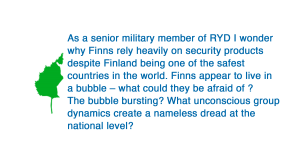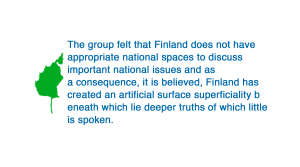This article is the result of the work of six members of the Finnish Think Tank: Dynamics of Groups and Societies (RYD). It is the continuation of a workshop led by Dr Mannie Sher of the Tavistock Institute of Human Relations in 2019. The authors of this article are Aki-Mauri Huhtinen, Sinikka Torkkola, Pertti Ahonen, Ilkka Väätti, Anja Salmi and Jaana Hallamaa who have joined together to illuminate possible unconscious reasons why Finnish society works against itself.

Aki-Mauri Huhtinen, LTC (GS), PhD), a military professor at the Finnish National Defence University in the Department of Leadership and Military Pedagogy: Why are Finns so fearful when they live in the safest country in the world?
Social media, journal articles and official statistics identify Finland as one of the happiest, safest and least corrupt countries in the world. Still, people complain about the bad weather and about how insecure they feel.
Finnish national culture values the virtue of modesty. We are sensitive to ‘reality’. We tend not to take seriously a person who is openly happy. A successful athletic declares: ‘The whole team worked hard’, suggesting how the individual does not express joyful feelings fully and veers towards modesty. 
It is generally considered better to express concern about possible worst future options or underline everybody’s hard work than to honestly express one’s own ‘here and now’ happy feelings. There is one exception, namely when one is drunk. It is a Slavic-based habit to honestly express one’s real feelings only while intoxicated. Younger Finns are desisting from ‘being able to be emotionally honest only when drunk’. Finns conceal their feelings when they speak. The way to find out how they feel is to watch what they do.
Reference: Kahn, William A.; To Be Fully There: Psychological Presence at Work. Pp. 335–336

Sinikka Torkkola, PhD, a Senior Research Fellow at the Tampere University: What measures should be taken to avoid the corruptive tendency towards corruption by the leadership of cities?
According to the corruption index of Transparency International, Finland is one of the least corrupt countries in the world. However, this does not mean that Finland is free of corruption. In a small country, everybody knows everybody else. If you do a favour for somebody today you can trust you will be paid back in one form or another tomorrow. There is very seldom a need for direct bribes. Finnish corruption is structural, which is considerably more difficult to detect than street-level corruption.
Furthermore, it is problematic to differentiate between ethically acceptable networking and a not-acceptable deal-making. Political decision-making is a part of the high-risk areas of corruption. Many politicians occupy many positions of trust at the same time and this may cause a conflict of interests. 
Local politics accepts the existence of multiple roles. A member of the city board may, for example, be the chair of a board of a city-owned company. The double roles are not generally illegitimate, but when it comes to decision-making, politicians with a double role are required to recuse themselves. The centralisation of power in the case of double or triple roles undermines the principle of neutral decision-making. I see these situations as symptoms of structural corruption. The smaller the circle of people in power, the more invisible becomes the justification for decisions. Invisibility and concentration of power feed corrupt behaviour by ignoring ethical codes and lawful norms.
Based on Finland’s reputation as an uncorrupted country, there is very little public discussion of structural corruption and its adverse consequences on Finnish society. At the same time, most citizens mistrust political decision-making. Politicians are rarely seen as fair people taking care of the collective good. They are rather perceived as opportunists looking after their own interests.
The mantra of a non-corrupt Finland is noxious and prevents observers from recognising and evaluating corrupted structures and practices. This non-seeing and non-evaluating culture erodes the functioning of the democratic society and its institutions.

Pertti Ahonen, D.Soc.Sc. (Political Science), M.Sc.Econ. (Accounting), Professor of Political Science at the University of Helsinki: How does the role of academia and its contribution to society fall short?
Recently, I was speaking to a colleague who had moved to another university from the University of Helsinki He said:
- Pertti, while working at the University of Helsinki, I used to feel I was politically much too much to the right, whereas at my new university, I constantly found myself much too much to the left.
- It is exactly the opposite with me, I replied.
Our discussion opened a perspective on the role of academia and its contribution. Let us take a glimpse at an array familiar to all who have ever used a voting advice application. Note that I have intentionally left out authoritarian alternatives. It looks as if it would be equally impossible for us, the academics, to find conciliation between the irreconcilably different views of the ‘ideal society’ and the different recipes to create this society, to work to its advantage and to live by its terms.
| The economy and the state | |||
| Mixed economy: regulated markets with an active state | Unregulated markets with a night watchman state | ||
| Culture and values | Traditional national, nationalist, religious, cultural or other values | Social conservatives including nationalists and ethnonationalists | Anarcho-conservatives including classical market liberals |
| Modern and post-modern global, globalist, cosmopolitan, Weltanschauung or other values | Social liberals including social democrats, greens, feminists, and religious liberals | Anarcholiberals such as libertarians | |
At first sight it looks as if no interaction would be possible between those positioned close to the four different corners of the four political platforms. However, I see light in the possibilities for us, the academics, to consider the minimal requirements for such interaction.
The requirements are analogous to those with which I came across while authoritarian regimes were being dismantled in the 1990s. Some countries went as far as writing such requirements in their constitutional legislation, and not all of these countries have slipped back into authoritarianism. 
I conclude that for the academic, committing oneself to any of the four types of political ideologies outlined in the figure is an allowable private decision, but not a solution for elaborating a role as a public academic contributing to the best of the world and humankind. I argue that the public role of the academic should transcend partisan roles of any sort. I also argue that to sharpen these roles we should carefully study the contributions of such figures as Gandhi and the exploits of recognised peacemakers, including Finland’s President emeritus Martti Ahtisaari, a Nobel Peace laureate.

Ilkka Väätti, a Doctor of Art and Visual Artist: Art casts a light on unconscious dynamics expressing things that cannot be said in words
In my pictures I have sought to connect past, present and future. During my numerous study tours, I have visited art museums and historical museums.
In 2016, I worked in the residence of the Finnish Institute in St. Petersburg. I had visited the art museum, The Hermitage, many times, but this time I looked in on departments where I had not been before.
I also made a short study tour to Novgorod where I got to know churches, monasteries and the famous collection of icons in the National Archives. 
In the ethnographic department of The Hermitage, I found a magnificent wrap for a horse that immediately made an impression on me. The colourful blanket originated from the Khanate of Khiva in Russia. This textile informed me not only about the society of its time but also evoked such conscious and unconscious feelings that cannot be described in words. I took a documentary photograph of the textile and later in Tampere I created a three-dimensional painting based on it. I gave the painting the name Hiva.
While wandering about in the ethnographic department, I accidentally came across a piece of wood, a split board, which was a part of a soldier’s shield from the eighth century from Mugh, Tazikistan. I named this Mugh the Emboss, which was born out of my desire to create my own interpretation of this strong and bright scale of colours after returning home.
I was particularly delighted by a little piece of mosaic that originated from the Novgorod Kremlin area from the floor of the St. Sofia Church. It evoked in me an indelible impression. In Finland, I painted an original of it, printed out a serigraphy of it and named it Novgorod.

Anja Salmi, MD, Psychiatrist: The impact of social trends on childhood development on psychological health in Finland
Mental health problems among the young are increasing even if the elements of a ‘good childhood’ as described by Lea Pulkkinen are fulfilled among many families. (egofunktio.fi/Koulutus/pulkkinen_2013.pdf). Our school system is in difficulties and the number of applicants for Teacher Training programmes has collapsed. Youth and the natural process of independence it entails are stretching out.
The change in social trends in child upbringing has gone through a tremendous swing. From the culture of physical punishment we have transferred to ‘good childhood’. In the meanwhile, we are allowing for the blurring of necessary boundaries.
Case 1: Minna’s mother came to the appointment after her daughter had shown symptoms of self-cutting and suicidality. It turned out that the parents had given everything to create a ‘good childhood’ for their child. In her treatment, only the boundaries placed by the mental hospital created sufficient security and possibilities for rebellion so that the process of independence could start. A laborious change in the family culture was able to release Minna from her helplessness, which had prevented her from encountering a world ‘without boundaries’.
Instead of parents’ constructive ‘rumbling’ the boundaries are often set by toothless discussions even with children under school age. As an end result of this the notion of good and bad becomes negotiable. By the ’rumbling’ here is meant an immediate aggressive tone reaction to what the child does that is wrong, which passes by quickly. It helps us to express ourselves when our borders have been crossed.
Given this change in childrearing, the interactions between adults and children have become increasingly unpleasant and decision-making in casual matters more difficult. The necessity for boundaries is placed upon parents, teachers, grandparents and nannies instead of children under school age themselves. This leads to a joint, sticky hardship without boundaries while ‘life loses its life’ and expressions of sincere negative and positive feelings become inhibited. Priorities turn upside down and, for example, the buddy relationships of four-year-olds outstrip the visits of grandparents.
Case 2: A forty-year-old doctor narrated at the appointment how sad he was when the relationship with his children and his mother had broken up. This happened because of his wife who had forbidden his mother to meet his children. When asked for an explanation he said his mother had bought a lottery ticket for his children and his wife saw this as exposing the children to gambling.
The ’rumbling’ of a parent raising the voice, establishing a boundary and setting right and wrong are building the child’s superego, which goes much beyond the case of the vanity feeding obsessions. It is an element of mind that is needed to protect an individual. It takes into consideration qualities similar to The Old Testament meaning of laws and commandments when one attempts to bridle our free-surging human instincts. It gives an individual the internal direction and courage to implement internal and external goals and values.
 Finland identifies with the West. Is it likely that the culture of our Eastern neighbour regarding child physical punishment has played a role in our way of eluding normal emotional communication in parenting by changing it into toothless coaxing. Identity is based on difference.
Finland identifies with the West. Is it likely that the culture of our Eastern neighbour regarding child physical punishment has played a role in our way of eluding normal emotional communication in parenting by changing it into toothless coaxing. Identity is based on difference.
Case 3: A colleague from Northern Finland commemorated her childhood. She described her father as having been a well-meaning polite gentleman whom she could not recollect ever getting angry. Once, her father was repairing a wooden object by the kitchen table when a rat ran across the room. In a moment, her father grabbed an axe from the table, threw it towards and hit the rat. The colleague said she then understood how it was not possible to play around with her father.
When reviewing the social trends of child rearing in relation to and their impact on the exponential growth of youth mental health problems, a lack of boundaries and excessive negotiability arise as obvious factors. The recognition of good and evil, right and wrong provide an individual the kind of security the present ‘non-rumbling’ child-rearing culture does not offer. The result is uncertainty and helplessness, which starts to govern the individual at the latest stage in the process of independence. The degree of difficulty in grounding one’s own life and finding one’s own satisfaction increases in the process of fulfilling one’s own endeavours in independent life.

Jaana Hallamaa, Professor of Social Ethics at the University of Helsinki, Faculty of Theology: The Church, its idealisation dynamics and the threat of corruption
Institutions that represent high ideals, such as religious communities and humanistic organisations, are prone to be tempted by a specific type of corruption. In a mediated society, companies have become weary of the economic risk embedded in moral wrongdoing. A tainted reputation is a major setback for any enterprise as it involves diminished trustworthiness and is likely to cause economic loss. Such risks often encourage the taking of shortcuts in commercial dealings.
For idealistic institutions, wrongdoing may become a long-standing practice, as thousands of child-abuse cases in the Roman Catholic Church and the numerous money and sex scandals of the American televangelists show. The aims of religious communities are morally praiseworthy, which leads to the assumption that what is done in their name, also follows their ideals. Typically, charismatic leaders and strong figureheads become personalised representations of such communities. The influence and power of the religious functionaries often gain further impetus through idealised projection.
Part of the projective process is that idealisation secures for the religious actors immunity from criticism. It then becomes difficult or even impossible to openly deal with shortcomings and even blatant wrongdoing in a religious organisation. Instead of analysing the breach of rules, there is a temptation to cover up anything untoward for the sake of protecting the public image of the community. Defensive mechanisms replace sound reasoning.
A standard procedure is to ‘shoot the messenger’ who has pointed out that there is something (wrong – they wonder why they are blamed for having unholy motives.) wrong: their criticism must stem from unholy motives. After downplaying the shortcomings, a series of statements follow, in which one explanation replaces another in step with each new point of criticism. Many of those who are convinced by bringing the facts to light, still wish to hush things up for the sake of serving the greater good. It is better to ‘wash one’s dirty laundry’ within the inner circle; the argument runs that it is unnecessary to endanger the public reputation of those involved. “Everybody makes mistakes”; “who do the critics think they are”, and “great personalities must have liberties that go beyond the petty rules designed for ordinary people” become excuses for not giving further notice to the matter.
Mannie Sher’s diagnosis of corruption in his Dynamics of Change: Tavistock Approaches to Improving Social Systems. London: Karnac (2013, https://www.scribd.com/doc/313529863/Chapter-10-Corruption#fullscreen), offers an insightful tool for understanding what is at issue for anyone who is willing to face the often painful truth instead of clinging to the comfort of defences.

